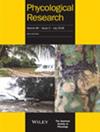实验室条件下全深海马尾藻(Phaeophyceae)的生长和光合生理学
IF 1
4区 生物学
Q2 MARINE & FRESHWATER BIOLOGY
引用次数: 0
摘要
全层马尾藻物种是加勒比海金色潮汐的罪魁祸首,通常被称为 "马尾藻事件"。这些事件主要由 Fluitans 马尾藻和 natans I 马尾藻组成,它们不仅暴露在高水平的辐照下,而且在其漂浮体中还会自我遮光。在本研究中,我们培育了 S. fluitans 马尾藻和 S. natans I 马尾藻,并在实验室中使它们适应 23°C 的低光照条件,以探索它们对光照强度增加的反应。对它们的光合作用、呼吸作用、生长和色素含量进行了为期 3 周的评估。S. fluitans 和 S. natans I 通过降低叶绿素 a 和 c 的含量来适应较高的辐照度。虽然饱和辐照度和光合作用与辐照度曲线的初始斜率存在差异,但在强光下观察到最大光合作用和呼吸速率均有所提高。这些调整反映在 S. fluitans 的日生长量(从弱光到强光下分别为 2% 到 7% d-1)和组织含氮量(1.6%-2.7%)中,但在 S. natans I 中却不存在(~1% d-1)。在这些条件下,S. fluitans 的光合生理表明其对光照的需求较低,但不会影响生长;不过,在强光下,光合作用表现较高。将全深海马尾藻物种的生理和生长研究结合起来,可作为了解和解释这些物种在加勒比海沿岸成功生长和过度生长的基准。本文章由计算机程序翻译,如有差异,请以英文原文为准。
Growth and photosynthetic physiology of holopelagic Sargassum (Phaeophyceae) under laboratory conditions
Species of holopelagic Sargassum are responsible for Caribbean golden tides, commonly known as ‘Sargassum events’. These events mainly comprise Sargassum fluitans and Sargassum natans I, which are exposed to high levels of irradiance, but also self-shading within their floating masses. In this study, we grew S. fluitans and S. natans I and acclimated them to low-light conditions at 23°C in the laboratory to explore their responses to increasing light intensities. Photosynthesis, respiration, growth, and pigment content were evaluated over 3 weeks. S. fluitans and S. natans I photoacclimate to higher irradiances by decreasing their chlorophyll a and c contents. An increase in maximum photosynthesis and respiration rates was observed under high light, although differences occurred in the saturation irradiance and the initial slope of the photosynthesis versus irradiance curve. These adjustments were reflected in S. fluitans daily growth (from 2% to 7% d−1 at low to high light, respectively) and tissue nitrogen content (1.6–2.7%) but were absent in S. natans I (~1% d−1). The photosynthetic physiology of S. fluitans under these conditions suggests lower light requirements without compromising growth; however, under high light a higher photosynthetic performance was observed. Combining physiological and growth studies in holopelagic Sargassum species will serve as a baseline to understand and explain the success and overgrowth of these species along the Caribbean coast.
求助全文
通过发布文献求助,成功后即可免费获取论文全文。
去求助
来源期刊

Phycological Research
生物-海洋与淡水生物学
CiteScore
3.60
自引率
13.30%
发文量
33
审稿时长
>12 weeks
期刊介绍:
Phycological Research is published by the Japanese Society of Phycology and complements the Japanese Journal of Phycology. The Journal publishes international, basic or applied, peer-reviewed research dealing with all aspects of phycology including ecology, taxonomy and phylogeny, evolution, genetics, molecular biology, biochemistry, cell biology, morphology, physiology, new techniques to facilitate the international exchange of results. All articles are peer-reviewed by at least two researchers expert in the filed of the submitted paper. Phycological Research has been credited by the International Association for Plant Taxonomy for the purpose of registration of new non-vascular plant names (including fossils).
 求助内容:
求助内容: 应助结果提醒方式:
应助结果提醒方式:


